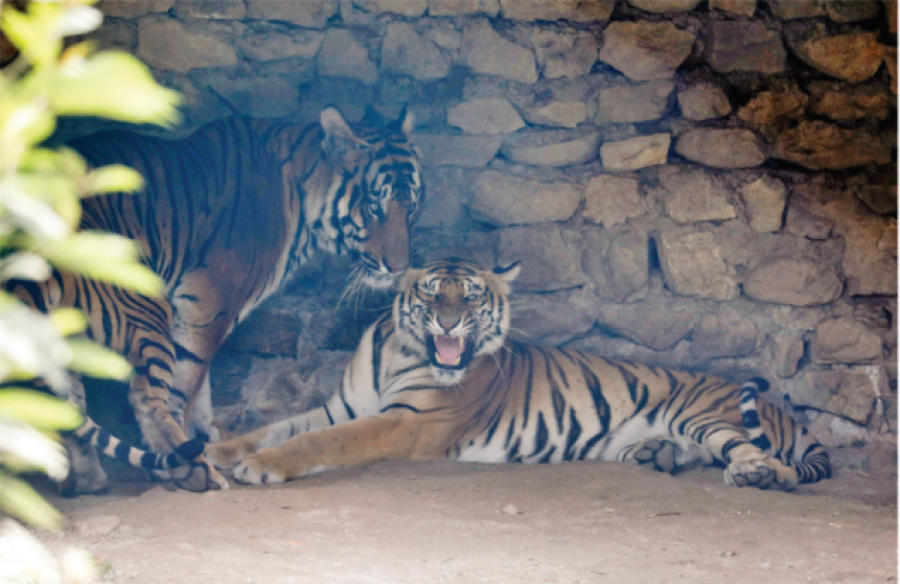Climate & Environment
Pandemic adds challenges for tiger protection, wildlife conservationists say
Since the pandemic struck, incidences of human-tiger conflict have gone up. Experts suggest considering why people trespass on protected parks and why animals are wandering out.
Chandan Kumar Mandal
The Covid-19 pandemic has added to the challenges of tiger conservation in Nepal, conservationists and wildlife experts have said.
The ongoing pandemic, which has caused hardships to the general public worldwide and impacted almost all sectors, has emerged as yet another challenge for the country’s tiger conservation efforts.
The immediate and tangible impact of the pandemic is that incidences of hostile interaction between tigers and communities have increased. There have been several incidents of tigers attacking and killing locals and livestock during the ongoing pandemic in different parts of the country.
According to official data, 11 persons were killed in Bardiya, two in Chitwan and one in Kailali districts in the current fiscal year.
During a virtual interaction on Friday, wildlife experts and conservationists said the Covid-19 pandemic had a significant role in the spike in such incidents, potentially brewing retaliatory perceptions among local communities towards tigers.
According to Babu Ram Lamichhane, a conservation biologist, the Covid-19 pandemic intensified the existing threats and challenges to protection of tigers in the country.
“Challenges like loss and degradation of tiger habitats, poaching and illegal trade, conflict with local communities, diseases and changing climate were already there. The ongoing pandemic has made them worse,” said Lamichhane, who has conducted several studies on tiger. “The Covid-19 pandemic has affected tiger conservation and posed more threats for the future.”
The ongoing fiscal year has seen frequent conflicts between tigers and locals around protected areas, mainly in Bardiya and Chitwan national parks. Tigers have not only killed locals inside forests but have also ventured out and snatched people from moving motorcycles. Locals around the Bardiya National Park are even scared to walk around during daytime, fearing tiger attacks.
Wildlife experts say recent attacks can be largely attributed to the Covid-19-induced restrictions.
“As tourism activities around protected areas were suspended, locals lost sources of income. Besides, people from cities and abroad have returned to their home villages after losing jobs,” said Lamichhane, who is also the chief of the Biodiversity Conservation Centre, Sauraha, under the National Trust for Nature Conservation. “Such people entered the national parks either to collect forest products or for recreation and came under tiger attack. Incidents like these can also fuel retaliatory killings of tigers by locals.”
As per official data, the number of human deaths in tiger attacks in Bardiya since 2019 until the start of the lockdown on March 23, 2020 was nine. The number has increased to 12 in over a year until now. Likewise, attacks on livestock have also gone up.
“Never before have such a large number of human casualties due to tiger attacks been reported. All these tragic incidents happened during the Covid-19 pandemic when locals entered forests,” said Sharad Chandra Adhikari, member-secretary of the National Trust for Nature Conservation.
“Our responsibility is to protect the wildlife while also protecting the humans. When the country is working to double its tiger population to 250 by 2022, the Covid-19 pandemic has come as a new challenge for tiger conservation. Due to the pandemic, authorities have not been able to carry out conservation activities. We need to study in detail how the pandemic has impacted the conservation sector.”
Nepal is home to 235 tigers as per the latest tiger census of 2018. As part of a global commitment, Nepal is working towards doubling its tiger population from its base population of 121 in 2009 to at least 250 by 2022. Experts say Nepal is likely to meet the target comfortably; however, unforeseen challenges like the Covid-19 pandemic may lie ahead.
“It seems the Covid-19 pandemic has increased negative interactions between tigers and humans, although conflicts involving humans and other animal species like monkeys, elephants, leopards are still prevalent,” said Prem Narayan Kandel, secretary with the Ministry of Forests and Environment Ministry. “We need to understand why people trespass on protected parks and why animals are wandering outside their habitats too.”
Besides rising conflicts involving tigers and humans, incidents of locals entering the protected areas during the pandemic is another threat, which could lead to poaching of the animal. Major protected areas around the country have seen an increase in incidence of trespassing by locals, which is also linked to the pandemic and lockdowns.
“Covid-19 has also amplified threats to tigers as we have limited knowledge on wildlife health. Covid-19 has been detected in zoo animals in India and other countries. A lion recently died of Covid-19,” said Lamichhane. “There is also a risk of potential transmission of the virus from humans to tigers and then also from tigers to other wild animals.”
As the Covid-19 concerns are still around, experts like Lamichhane call for concerted efforts from all sides for protecting tigers and other wild animals, which could be directly and indirectly facing threats of the global pandemic.
“We saw wildlife came under threat during the armed conflict. We need to remain on alert and discuss whether Covid-19 will also have an impact on the future of our tigers because the pandemic is likely to stick around for some time,” said Lamichhane. “We surely do not want to stop our conservation efforts after achieving the target of 250 tigers. We need to prepare for the worst as there are predictions of a third wave of the pandemic and prioritise our actions.”




 9.12°C Kathmandu
9.12°C Kathmandu










